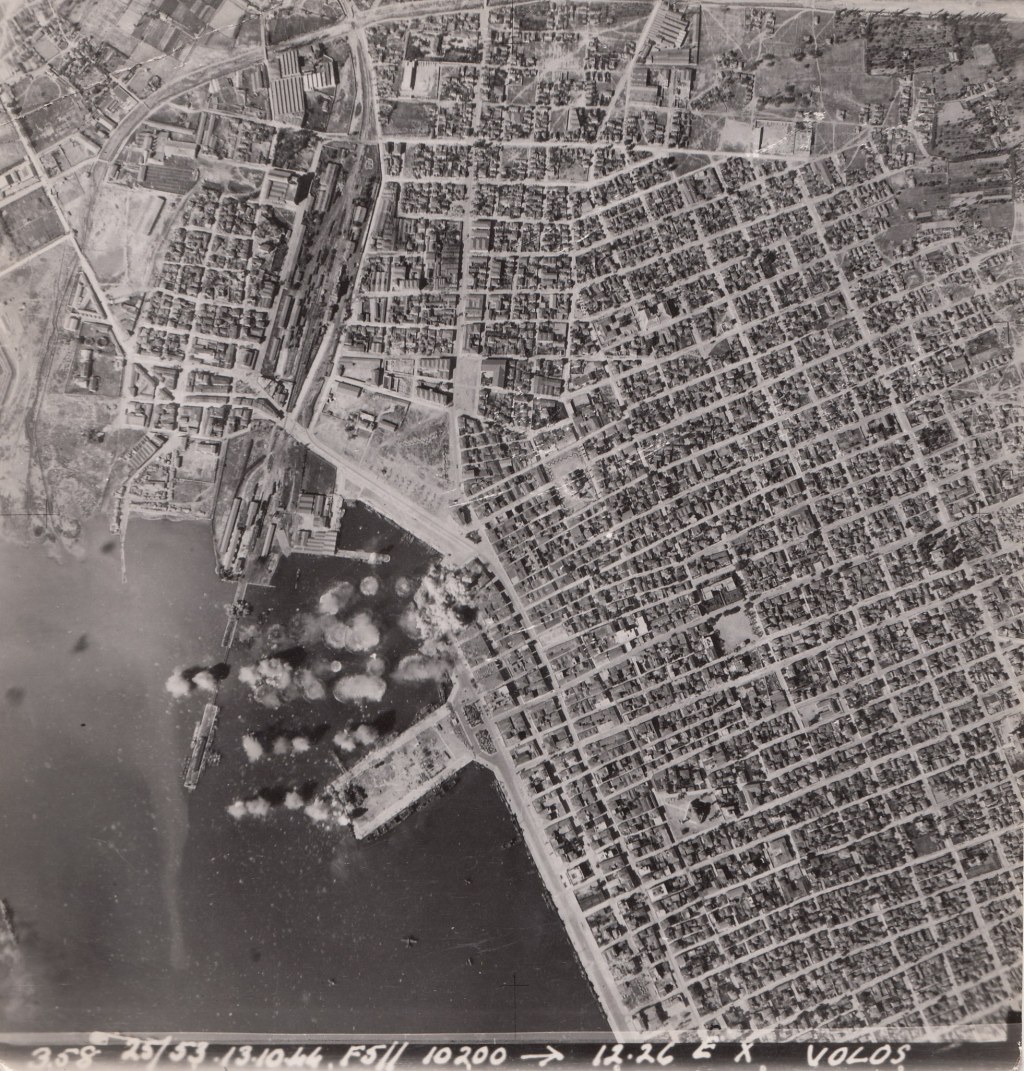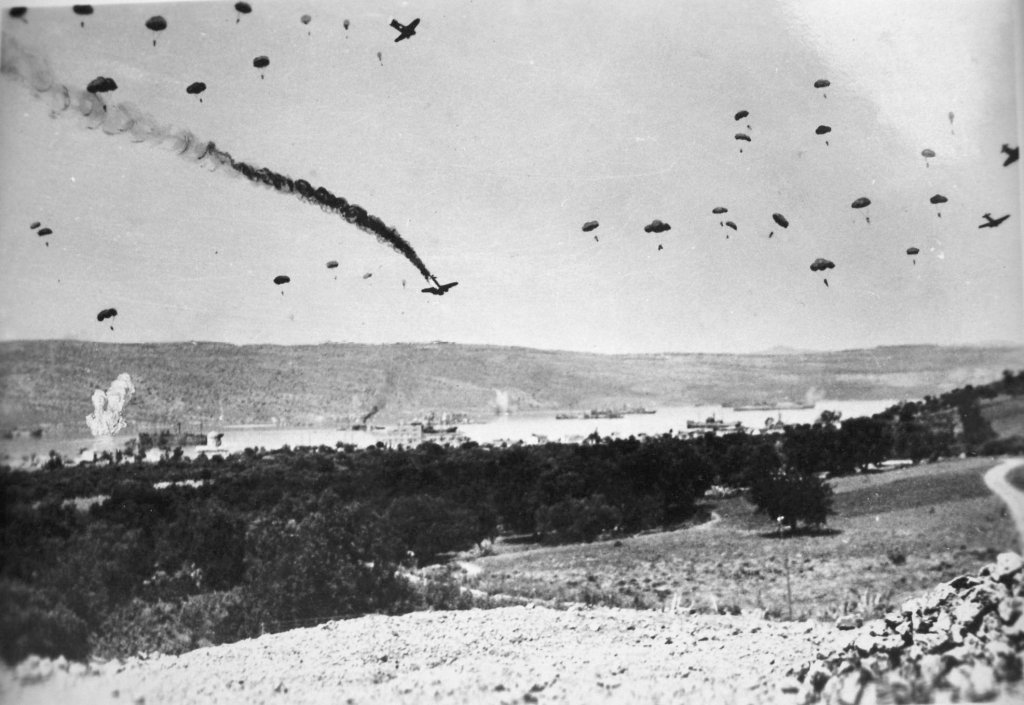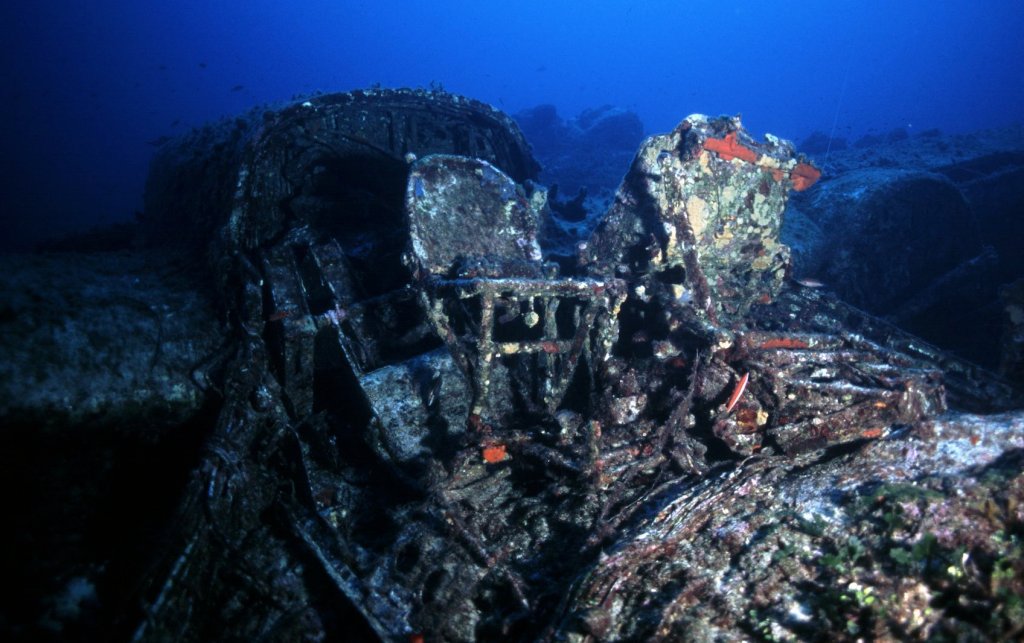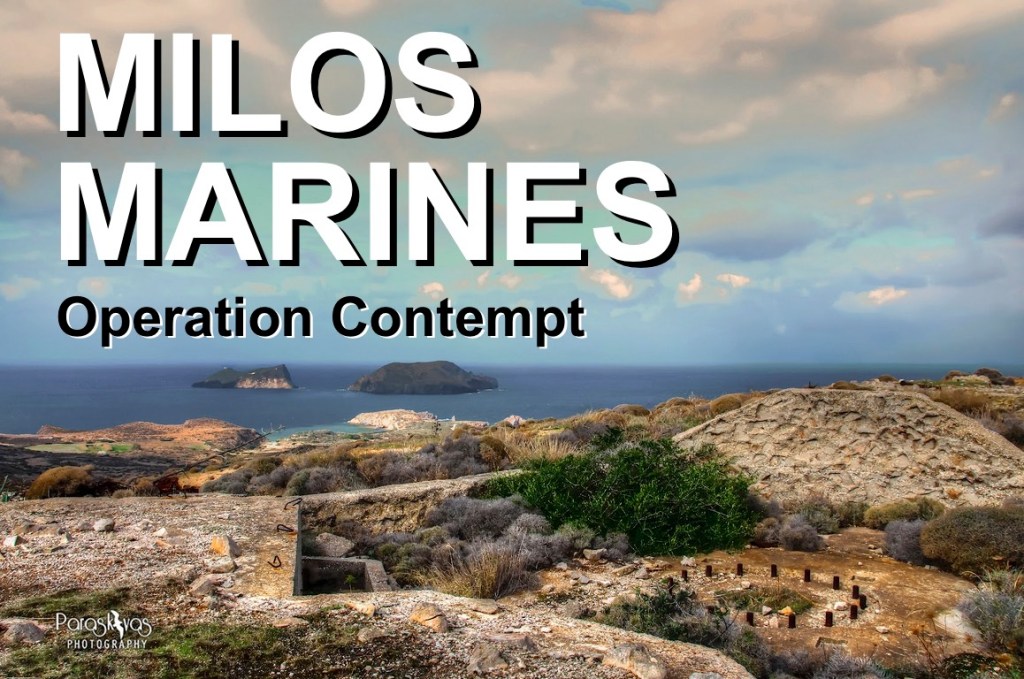This article was first published in the volos newspaper, Taxydromos on 13 October 2019, commemorating the 75th anniversary of the event.
Ross J. Robertson researches the official wartime archives to reveal more about the Allied bombing of the Volos harbour during WWII.
Κάντε κύλιση προς τα κάτω για το άρθρο στα Ελληνικά. [Scroll down for Greek version]
Friday the 13th October 1944 began in the Greek city of Volos much like any other. Starved and subjugated, its citizens managed as best they could under the merciless Nazi regime. In a nondescript area of town, the ‘Kítrino Apothíki’ still stands as testimony to those dark days. Countless were incarcerated and tortured within its imposing grey walls. Far too many did not survive. After the abortive 1940 invasion by Italian fascists, it had taken just three weeks after crossing the Metaxas Line on 6th April 1941 for the Germans to successfully Blitzkrieg their way through the whole country. Volos had continued to languish under its oppressors since then.

However, by the autumn of 1944, the tides of war were seriously turning against Hitler. A string of defeats which included the loss of North Africa, the D-Day landings in Normandy and the successful Allied liberation of the Italian peninsula right up to the Gothic Line were making a mockery of the promised 1,000 year Reich. More worrying for the German occupiers was that targets in Yugoslavia and Albania were under constant air attack, thus clearing the Adriatic and causing havoc to supply lines to Greece. Importantly, the Red Army was fighting back the Germans on a front stretching from the Baltic to the Black Sea. By August 1944, they had ousted the Wehrmacht from Romania and absorbed the former Axis power into the growing Soviet territories. Bulgaria, which had annexed the Greek regions of eastern Macedonia and western Thrance for the Germans in 1941, would be next.
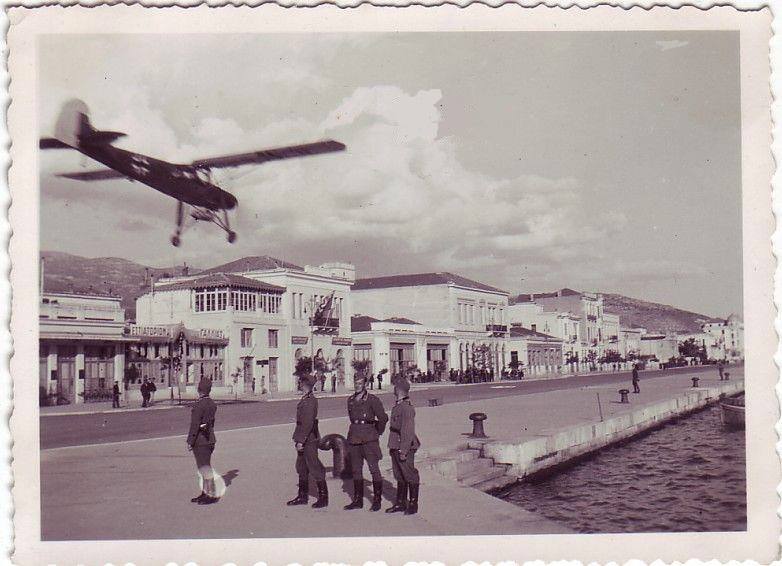


The growing threat of being cut-off from the Fatherland was a problem further compounded by other factors. Despite the previous year’s brutal but successful counter-operations undertaken by elite German troops against ELAS and EDES, these politically opposed Greek resistance groups remained a thorn in the oppressor’s side. Moreover, the Allies were using the ground gained in Italy to launch an ever increasing number of air sorties on German shipping and military targets in Greece.
“Volos had suddenly become a high-priority target.”
Any elation felt by the citizens of Volos on learning that the Germans had finally evacuated Athens on October the 12th was to be short-lived. By the morning of the 13th, its harbour was brimming with vessels which had fled Piraeus over the previous two days. The Allies soon became aware of this fact. One report confirms that “an unusual concentration of shipping was laying in the main harbour.” Unknown to its citizens, Volos had suddenly become a high-priority target.
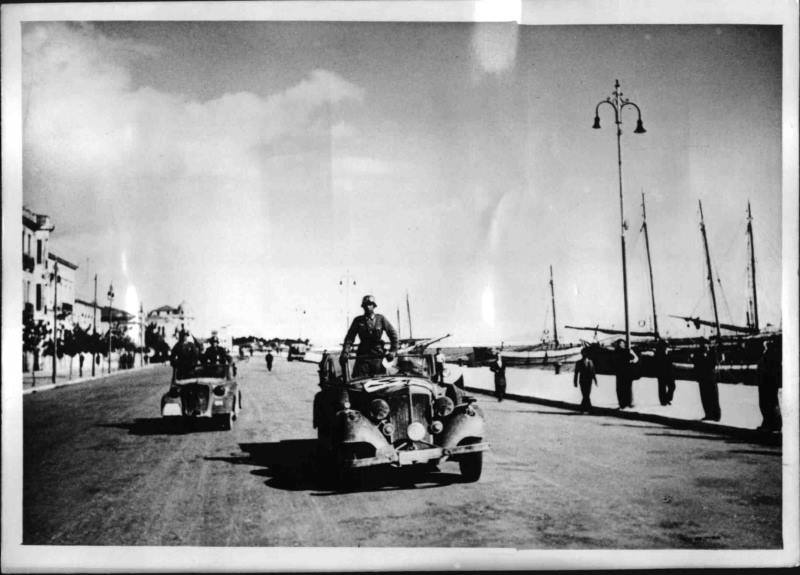
Source: Unknown
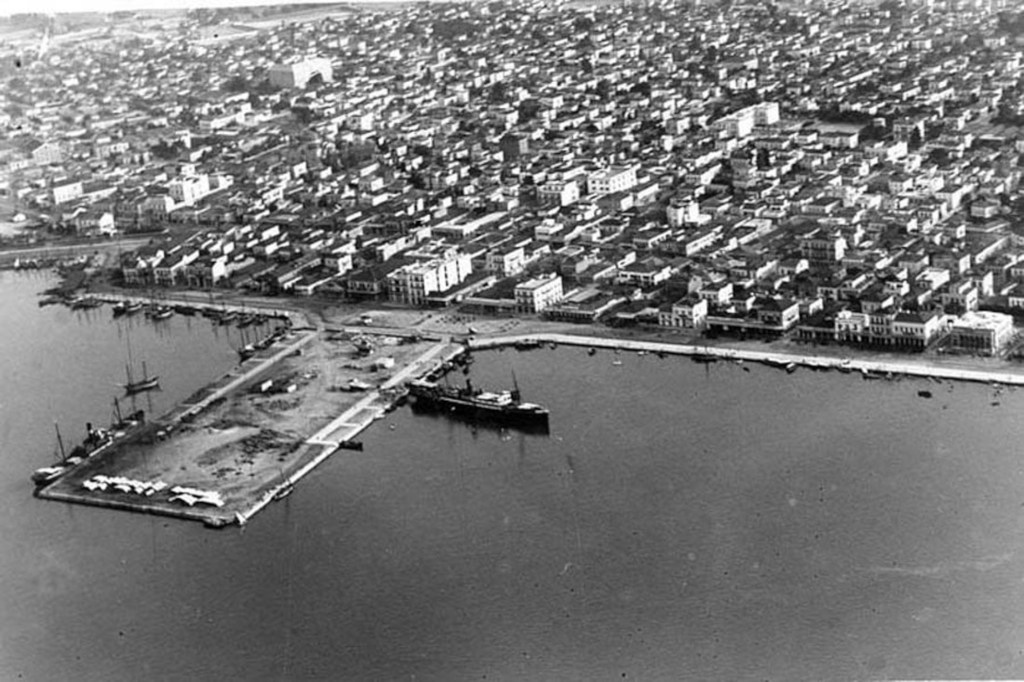
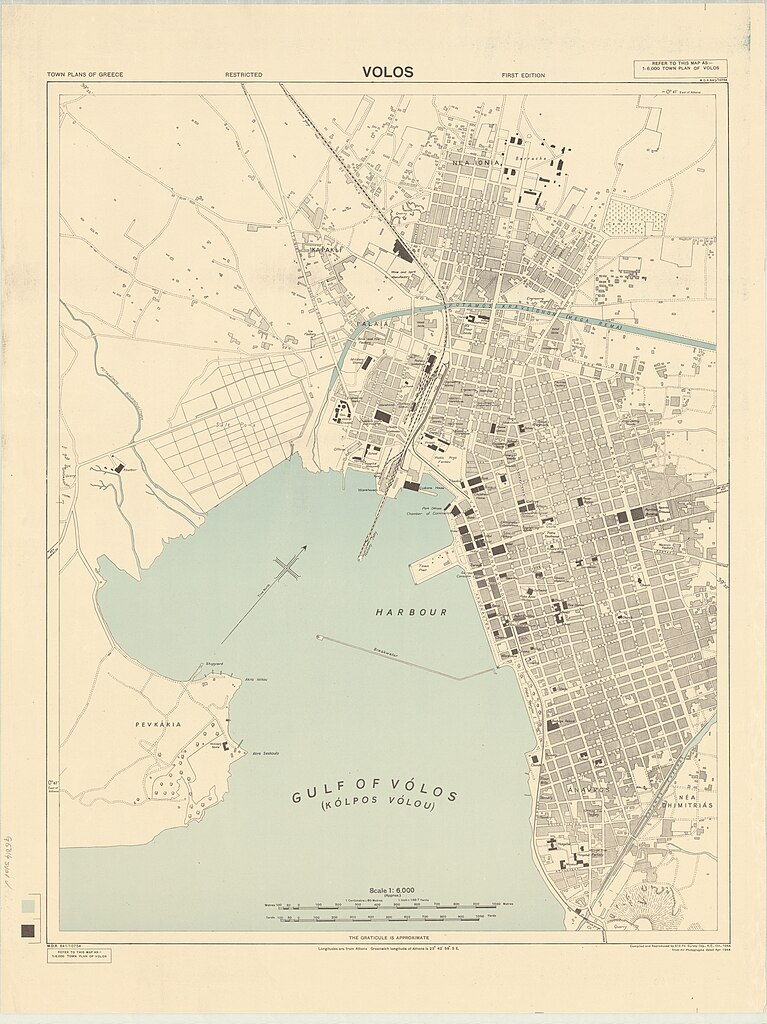
Buried in the official archives for the last 75 years are the details of what happened next. Only by careful scrutiny and cross-referencing of the Allies’ declassified Top Secret War Dairies can the full story to be brought to light. The reward for this painstaking process is that new insights and twists to the tale can be substantiated.
As the citizens of Volos slept that Friday, final flight preparations for another mission over enemy territory were being made. Operation 54 was to be carried out by the No. 25 Squadron of the SAAF (South African Air Force). At 07:10 hrs, a flight of twelve Ventura bomber aircraft commanded by Lieutenant Colonel Shuttleworth took off from Biferno, Italy. Each carried a deadly payload of 2,500 Ibs (1,200 kg). At 08:30 hrs, the flight landed in Brindisi for refuelling and a final briefing. Unluckily, one of the aircraft had developed a mechanical issue and was forced to withdraw. When the remainder of the flight took off again at 10:55 hrs, another aircraft was late getting airborne due to starting problems. It eventually returned to Biferno at 14:00 hrs, after having failed to catch up with the rest of the flight. As the remaining ten aircraft headed for Greece, they were escorted by three Royal Air Force (RAF) Spitfires.
Just thirty minutes into their journey, yet another aircraft reported engine trouble and was forced to return to Brindisi. Only nine aircraft were now left. Incredibly, Flight Commander Shuttleworth also experienced engine trouble by the time they reached the Greek coast. Knowing that his withdrawal would seriously compromise the mission, he decided to press on. Fortunately, the trouble was to eventually resolve itself.
Unbeknown to Shuttleworth, more information about the target was coming in. RAF Middle East Intelligence Summary No. 226 states that at 10:10 hrs, “Over 70 active vessels were present in the harbour, including the SS Adriana (4,353 GRT) and SS Lola (1,193 GRT), 2 War Partenope Destroyers (Italian warships commandeered by the German Kriegsmarine), 2 Corvettes (patrol and convoy warships), 7 Coasters (merchant transport ships) and Danubes (barges), 17 caiques (sailing boats) and nearly 40 small escort vessels of various types.” This very detailed information came “from the field,” meaning that in all likelihood, someone had a morse radio and was risking life and limb to spy on the Germans.
Archival research suggests a high likelihood that a covert, three-person Office of Strategic Services (OSS) group known as Horsebreeders served as the information source. According to the OSS War Report for the U.S. War Department, “HORSEBREEDERS was tasked with infiltrating Volos, a significant port with limited intelligence output.” Prior to joining the U.S. Army, the team’s leader, whose name is not disclosed, had extensive experience working as a British agent in Crete. Stationing themselves in Kerasia, a village near Volos, the HORSEBREEDERS leader used EAM (National Liberation Front – a communist-orientated Greek resistance movement) help to establish a network of approximately 500 subagents, covering Volos and the Thessaly plain to the north. In addition to their own radio equipment and operator, they recruited and trained radio operators in the field. They set up a radio station near Lamia and another on nearby Skiathos Island to monitor ship traffic along the crucial Pireaus-Salonika route through the Skiathos Straits. Moreover, they established five observation posts which were in direct contact by telephone line. This allowed them to have immediate awareness of all shipments to Volos Port and from Euboea Island to the Thermaic Gulf. Two of these posts also monitored transport movements on the roads from Volos to Larissa and Volos to Almyros, as well as the railway line from Volos to Larissa. Agents were strategically placed at town entrances to observe incoming and outgoing military materials, repeating this procedure in ports, aerodromes, and railway stations. Reports included details on enemy transport and movements with precise timing throughout their operational area. The OSS War Report summarises Horsebreeders as: “Of all the Secret Intelligence (SI) teams, probably the most successful” and “their accomplishments were spectacular”. Incidentally, the OSS was disbanded on 1 October 1945 but survived as the precursor of the CIA (est. September 1947). 1
A few hours later, the flight approached the target in clear skies at 10,000 feet (3,000 m) on a bearing of 40 degrees. They were unaware that the SS Lola and the two Destroyers had avoided the impending attack and were steaming towards Thessaloniki.2
Twenty seven 500 lb (220 kg) and thirty six 250 lb (110 kg) high explosive bombs were dropped in rapid succession. As they rained down, the SS Adriana, the largest enemy motor vessel in the Aegean area, was set ablaze and began billowing smoke. One of the Corvettes, the ‘Bridgette’, was sunk, as too was the Danube barge ‘Laudon’ (378 GRT). A host of smaller vessels were also either sunk or destroyed in the firestorm. Even a Ju-52 Seaplane was sent straight to the bottom after a direct hit. A huge secondary explosion left a gaping 150 foot (50 m) hole in the quay and damaged “three large blocks of buildings on the quayside.” It had been caused by an ammunition dump being ignited by the mayhem. Other explosions were reported to continue for over ten minutes after the attack.

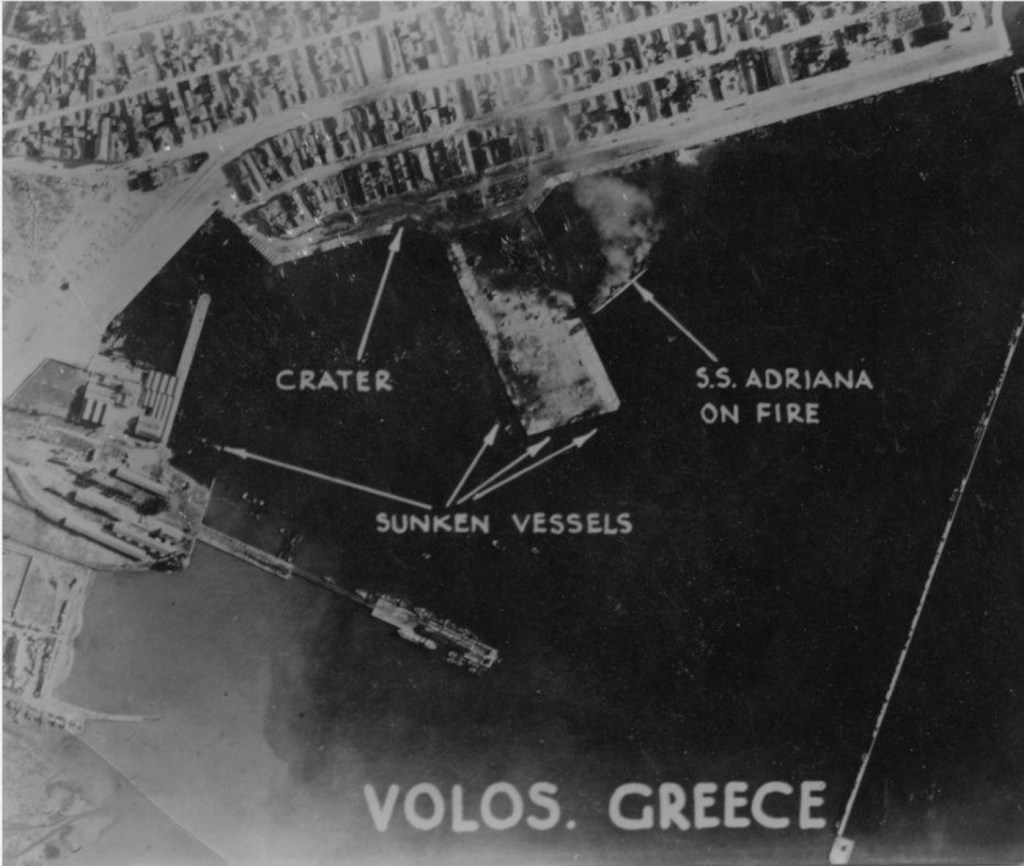

The material damage was substantial. No one knows how many German casualties there were. In return, the raiders had faced “intense” light and “scant” heavy anti-aircraft fire from warships and ground positions. However, not a single aircraft was hit. As they headed for home, it was noted that plumes of black smoke from the destruction they had wrought could be seen 60 miles (100 km) away.


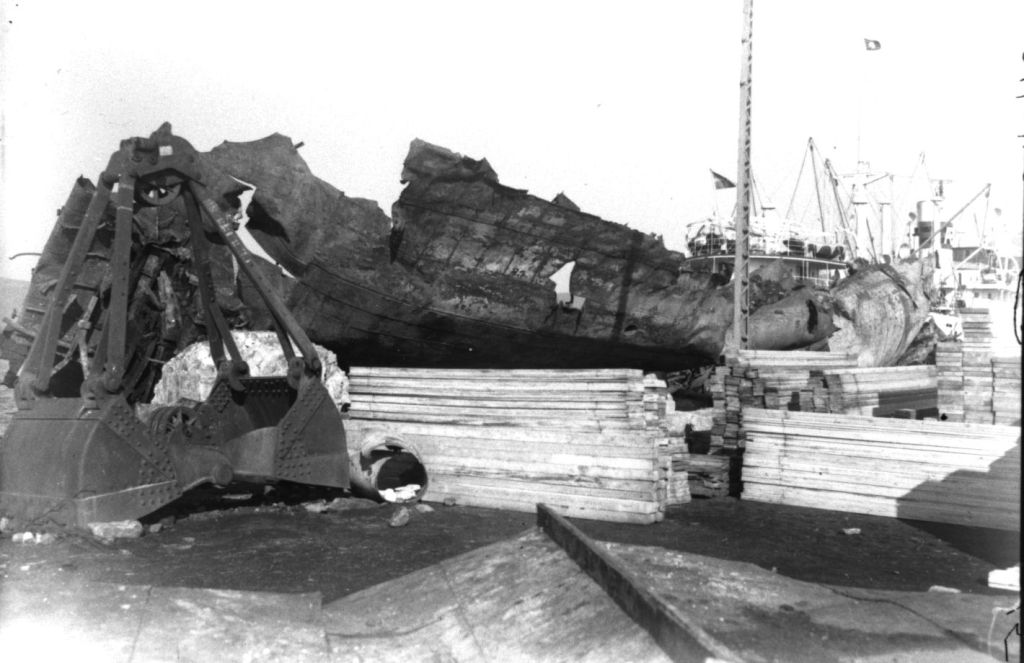
Source: Volos Municipality Digital Archive ©
The flight reached Brindisi at 14:15 hrs and safely returned to Biferno at 16.22 hrs. Photo reconnaissance made the following day confirmed that the raid had been highly effective, despite the depletion in the number of participating aircraft due to mechanical failure. Bombing runs during WWII were notoriously inaccurate. However, No. 25 Squadron had been surgical. The town had been spared the possibility of major destruction. In a message of congratulations sent to the SAAF shortly afterwards, the Air Officer Commanding described the action as an “an excellent performance.”


The archives also report another operation on the 13th, this time by a detachment from No. 6 Squadron of the RAF. At 07:45, four Hurricane IV’s commanded by Squadron Leader R. H. Langdon-Davies took off from the recently captured airfield at Araxos, just outside Patra. This reconnaissance mission reached Volos hours before the SAAF bombing, but failed to be an unintended forewarning for the Germans. A lot of shipping in the harbour was observed, including “one large merchantman with steam up.” Although it remains unconfirmed, this could very well have been the SS Lola preparing to leave for Thessaloniki. On the way back, they saw a stationary convoy of around 50 motorised transport vehicles near Thiva. They also reported another convoy of 30 motorised transport vehicles on the Thiva to Lamia road. Inexplicably, these fleeing Germans stopped when spotted and someone from the lead vehicle fired a red flare at the aircraft. 3
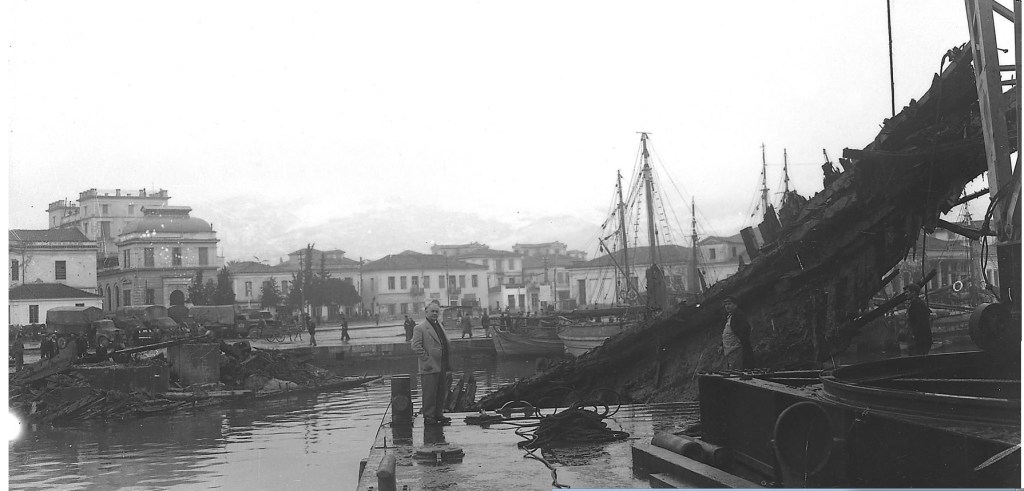

Sources: Volos Municipality Digital Archive and Author ©
Despite the SAAF’s resounding success, No. 25 Squadron conducted Operation 58 just three days later, on the 16th. Notwithstanding cloud interference, one of the eight Venturas sent on the raid scored a direct hit on a 1,000 ton ship, setting it on fire. Further hits near the quay where the Hellenic Coast Guard building stands today and the railway jetty to the north destroyed “at least 2 of the 6 to 8 vessels moored alongside.” The overall damage this time, however, was far less. The Germans had learnt from their mistake and had dispersed whatever viable shipping which remained from the previous raid outside the harbour. RAF Intelligence reported that the SS Adriana was “listing heavily to starboard and still on fire.” They confirm that she had been carrying troops and heavy equipment from the Athens area.


Volos was again visited on the 17th, but this time by No. 809 Squadron of the Air Fleet Arm (i.e. the Royal Navy). Two flights of Supermarine Seafires (a naval adaptation of the Spitfire) were launched from the aircraft carrier HMS Hunter. Having sailed from Alexandria, Egypt she was now in the Aegean as part of ‘Operation Manna’ (the liberation of Greece). They attacked Volos harbour, sinking a Dornier Do-24 (a three engined German Flying Boat).4
On the 22nd, a single RAF Spitfire VB piloted by Flight Officer J. S. Anderson of No. 94 Squadron flew over Volos at 1,000 ft (300 m) on a reconnaissance mission. He reported a 1,000 ton ship “with her stern to the quayside.” 5 That was followed the next day by a single RAF Supermarine Spitfire VIII from No. 32 Squadron. It had taken off from the recently acquired Kalamaki airfield in Athens to reconnoitre the Pagasetic Gulf and the area around Volos. A derelict ship was sighted off Almiros bay. Among the many sunken vessels, the same 1,000 ton ship was observed in Volos harbour. To the north west, no convoys on the road from Volos to Larissa were seen. All bridges on the road were reported to be blown up and the railway track destroyed in several places. 6
Even before these last missions, the focus of attention had shifted away from Volos and to the north as the Allies hounded and harassed their enemy’s withdrawal. It turned out that the Germans could retreat just as fast as they had arrived. By the end of October, they were out of the mainland altogether, with only Crete and isolated islands remaining occupied but cut-off. To its great fortune, the township of Volos had physically survived the liberation unscathed. The human toll in terms of horrendous suffering and lives ruined or lost is another matter entirely.
As for the numerous wrecks left littering the harbour, they would eventually be removed and salvaged for scrap. It is, however, an intriguing notion that twisted metal pieces and other remnants of the attacks, including the shattered parts from both Seaplanes, must still lie at the bottom. Perhaps fragments of the very bombs that caused the destruction also remain. Covered by silt and hidden under water, these artefacts have become very much like the memory of this major event in local history; both are largely forgotten as they slowly erode away with time.
Επίσης, στα Ελληνικά!
Κάντε κύλιση προς τα κάτω για το άρθρο στα Ελληνικά. [Scroll down for Greek version]
Delve Deeper
Read the primary resource materials yourself from the microfilm SAAF archives.
- ‘OPREP’ or ‘Operation Reports’ filed by the Officer Commanding No. 24 Squadron SAAF for October 1944 (Ref: 25SQ/24/6/4):


2. No. 24 Squadron SAAF ‘Operational Review’ for October 1944:

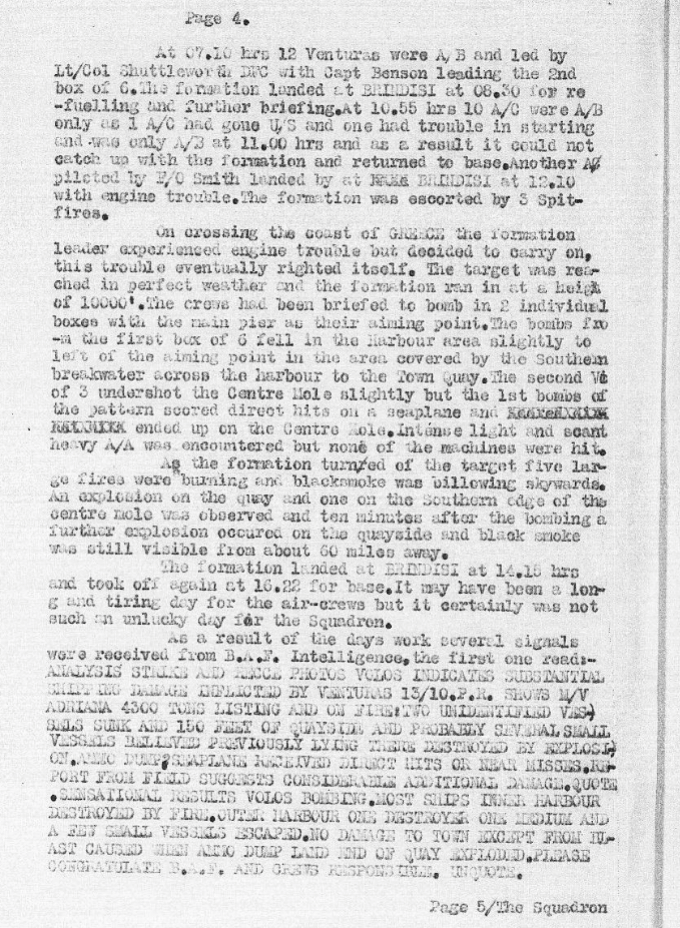
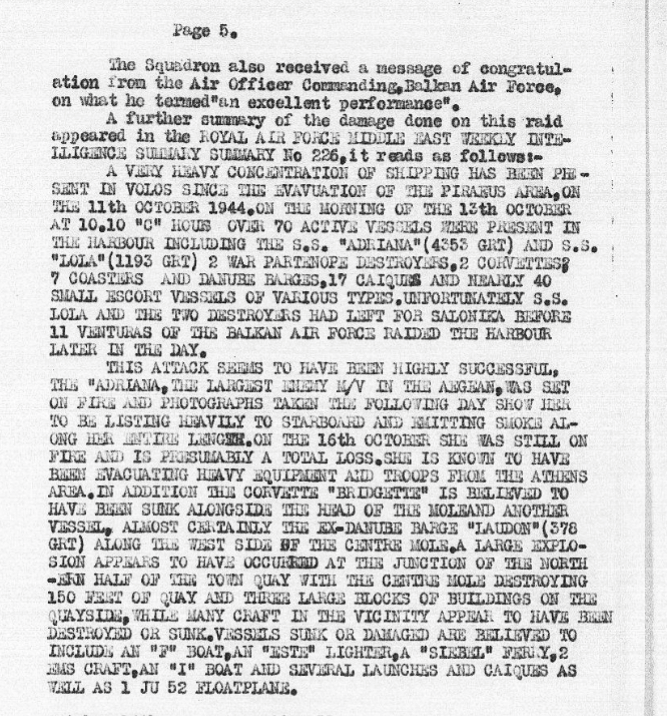
3. The German Naval Staff Operations Division. War Diary. Part 1, Vol. 64, October 1944 (translated for the War Dept. Washington DC), p 294:

Footnotes
- War Report, Office of Strategic Services (OSS) History Project Vol. II. Strategic Services Unit, Office of the Assistant Secretary of War, The War Department, Washington, D.C., pp 121-122.
↩︎ - “The steamer LOLA has arrived as planned at Salonika. With that, the responsibility of Army Group E as to the transport of troops has been fulfilled.” German Naval Staff Operations Division. War Diary. Part 1, Vol. 64, October 1944. Washington, D.C.: Office of Naval Intelligence, 1948-1955, p 314.
↩︎ - “4 aircraft airborne ARAXOS on armed recce of VOLOS and GULF OF PAGASAI area. Shipping observed in VOLOS which included 1 large merchantman with steam up. 1x 90ft schooner attacked by 4 aircraft firing RP’s on the coast 10 miles N. of SIKI. Claimed damaged. 1x 40ft auxiliary caique claimed sunk in same area. As THIEVE about 50 M.T. observed stationary. On road joining THIEVE to LAMIA a convo of 30 MT became stationary when spotted, and leader of convoy fired red Verey light. Rolling stock seen in siding at THIEVE and 1 engine hauling 20 trucks heading West, on the East side THEIVE. All aircraft landed safely.” No. 6 Squadron RAF Operations Record Book, October 1944. AIR-27-77-16
↩︎ - “Two flights bombed Volos harbour and sank a Do24 as it was lifting off.” No. 809 Squadron FAA Record Book, October 1944 (assigned to HMS Stalker at the time). ADM_207_10_003
↩︎ - “1 A/C. carried out recce. over Volos harbour at 1000ft. One 1000 ton ship was seen with the stern to the quayside. Visibility excellent.” No. 94 Squadron RAF Operations Record Book. October 1944. AIR-27-757-20
↩︎ - “One aircraft carried out a reconnaissance of the Gulf of PAGASI; no activity was observed there. A derelict ship in Almiros Bay and eight sucken ships in VOLOS harbour and a 1000 tonner at the quay were sighted. There were no convoys in the road from VOLOS to LARISSA and all the bridges were blown; the rail track was destroyed in several places. On LARISSA airfield eight to ten dummy Me.109s were noticed.” No. 32 Squadron RAF Operations Record Book, October 1944. AIR-27-363-19
↩︎ - War Report, Office of Strategic Services (OSS) History Project Vol. II. Strategic Services Unit, Office of the Assistant Secretary of War, The War Department, Washington, D.C., pp 121-122.
↩︎
We value your opinion!
Your feedback is important to us. If you enjoyed this article and would like to see similar content, show your appreciation by clicking the ‘Claps’ icon below. Also, ensure you stay up-to-date with our latest articles by subscribing to our Newsletter on the Home Page. You’ll receive new posts directly to your email inbox. Thank you for your support!
‘History has to be shared to be appreciated’
Subscribe to our Mailing List. We’ll keep you in the loop.
Ο Βομβαρδισμός του Βόλου κατά τον Β ‘Παγκόσμιο Πόλεμο
Η μετάφραση στα ελληνικά έγινε από τον Γιώργο Κωστήρα & Dr Κώστας Γιαννάκος.
Σημείωμα του Εκδότη: Ο Ross J. Robertson ερευνά τα επίσημα αρχεία του πολέμου, για να αποκαλύψει περισσότερα για το βομβαρδισμό του λιμανιού του Βόλου από τους συμμάχους κατά τη διάρκεια του Β ‘Παγκοσμίου Πολέμου.
Στις 13 Οκτωβρίου το 1944, ξημέρωσε για την πόλη του Βόλου μια Παρασκευή όπως κάθε άλλη συνηθισμένη μέρα. Πεινασμένοι και υποταγμένοι, οι πολίτες της κατάφερναν να διαχειρίζονται την καθημερινότητα τους όσο καλύτερα μπορούσαν, κάτω από τον ζυγό ενός ανελέητου ναζιστικού καθεστώτος. Η “Κίτρινη Αποθήκη“, στη διασταύρωση των οδών Βασσάνη και Γαζή, εξακολουθεί να αποτελεί μαρτυρία για εκείνες τις σκοτεινές μέρες. Αμέτρητοι φυλακίστηκαν και βασανίστηκαν εκεί μέσα, πίσω από τους επιβλητικούς γκρίζους τοίχους της. Πάρα πολλοί δεν επιβίωσαν. Μετά την αποτυχημένη εισβολή των ιταλών φασιστών το 1940, χρειάστηκαν μόλις τρεις εβδομάδες μετά τη διέλευση της συνοριακής Γραμμής του Μεταξά στις 6 Απριλίου 1941 και μετά από ένα πόλεμο-αστραπή ,για τους Γερμανούς να καταλάβουν επιτυχώς ολόκληρη τη χώρα. Έκτοτε, ο Βόλος συνέχιζε να υποφέρει κάτω από τους δυνάστες του.

Ωστόσο, έως το φθινόπωρο του 1944, οι παλίρροιες του πολέμου είχαν αρχίσει να στρέφονταν σοβαρά κατά του Χίτλερ. Μια σειρά από ήττες, που περιλάμβαναν την απώλεια της Βόρειας Αφρικής, την απόβαση (ημέρα D) στη Νορμανδία και την επιτυχημένη απελευθέρωση από τις Συμμαχικές δυνάμεις της ιταλικής χερσονήσου έως τα Γοτθικά σύνορα, χλεύαζαν την υποσχόμενη 1000ετια του Ράιχ. Μεγαλύτερη ανησυχία για τους Γερμανούς κατακτητές αποτελούσε το γεγονός ότι στόχοι στη Γιουγκοσλαβία και στην Αλβανία δεχόταν συνεχείς αεροπορικές επιθέσεις, φέρνοντας έτσι εκκαθάριση στην Αδριατική και προκαλώντας όλεθρο στις γραμμές εφοδιασμού προς την Ελλάδα. Σημαντικό επίσης το γεγονός, ότι ο Κόκκινος Στρατός αντιστεκόταν πολεμώντας τους Γερμανούς σε ένα μέτωπο που εκτεινόταν από τη Βαλτική έως τη Μαύρη Θάλασσα. Μέχρι τον Αύγουστο του 1944, είχαν απομακρύνει την Βέρμαχτ από τη Ρουμανία και η πάλαι ποτέ δύναμη του Άξονα είχε απορροφηθεί στα αυξανόμενα σοβιετικά εδάφη. Η Βουλγαρία, η οποία είχε προσαρτήσει τις ελληνικές περιφέρειες της ανατολικής Μακεδονίας και της δυτικής Θράκης για τους Γερμανούς το 1941, θα ήταν η επόμενη.



Η αυξανόμενη απειλή της αποκοπής από την Πατρίδα, ήταν ένα πρόβλημα που γινόταν ακόμη πιο σύνθετο και εξαιτίας άλλων παραγόντων. Παρά τις θηριώδης αλλά επιτυχείς επιχειρήσεις του προηγούμενου έτους, που διεξήγαγαν ελίτ γερμανικά στρατεύματα, κατά του ΕΛΑΣ και του ΕΔΕΣ, αυτές οι πολιτικά αντίθετες ελληνικές ομάδες αντίστασης παρέμεναν αγκάθι για τον δυνάστη. Επιπλέον, οι Σύμμαχοι χρησιμοποιούσαν το έδαφος που είχαν ανακτήσει στην Ιταλία, για να εξαπολύουν έναν συνεχώς αυξανόμενο αριθμό αεροπορικών εξορμήσεων σε γερμανικούς ναυτιλιακούς και στρατιωτικούς στόχους στην Ελλάδα.
Ο όποιος ενθουσιασμός που ένιωσαν οι πολίτες του Βόλου όταν έμαθαν ότι οι Γερμανοί τελικά εκκένωσαν την Αθήνα στις 12 Οκτωβρίου, ήταν βραχύβιος. Μέχρι το πρωί στις 13 Οκτωβρίου, το λιμάνι του ήταν γεμάτο με πλοία που είχαν τραπεί σε φυγή από τον Πειραιά, δύο ημέρες νωρίτερα. Οι Σύμμαχοι σύντομα έλαβαν γνώση αυτού του γεγονότος. Μία έκθεση επιβεβαιώνει ότι «μια ασυνήθιστη συγκέντρωση από πλοία βρισκόταν στο κύριο λιμάνι». Ο Βόλος, είχε ξαφνικά γίνει στόχος υψηλής προτεραιότητας.

Source: Unknown


Θαμμένα στα επίσημα αρχεία για τα τελευταία 75 χρόνια, είναι οι λεπτομέρειες του τι συνέβη στη συνέχεια. Μόνο με προσεκτική εξέταση και διασταύρωση των αποχαρακτηρισμένων Άκρως Απορρήτων Πολεμικών Αρχείων των Συμμάχων, μπορεί να αναδειχθεί ολόκληρη η ιστορία. Η ανταμοιβή για αυτή την ενδελεχή διαδικασία, είναι ότι νέες γνώσεις και ανατροπές στην ιστορία μπορούν να τεκμηριωθούν.
Καθώς οι πολίτες του Βόλου κοιμόντουσαν εκείνη την Παρασκευή, τελικές προετοιμασίες για μια άλλη αποστολή σε εχθρικό έδαφος λάμβαναν μέρος. Η επιχείρηση 54, θα διεξαγόταν από την 25η Μοίρα της SAAF(Πολεμική Αεροπορία της Νοτίου Αφρικής). Στις 07.10 η ώρα, ένα σμήνος από δώδεκα αεροσκάφη βομβαρδιστικών αεροπλάνων τύπου Ventura, υπό την διοίκηση του αντισμήναρχου Shuttleworth, απογειώθηκε από το Biferno της Ιταλίας. Το κάθε αεροπλάνο, έφερε μαζί του από μια θανατηφόρα βόμβα των 2.500 λιβρών (1.200 κιλά). Στις 08.30, το σμήνος προσγειώθηκε στο Μπρίντιζι για ανεφοδιασμό και για μια τελευταία ενημέρωση. Δυστυχώς, ένα από τα αεροσκάφη παρουσίασε μηχανική βλάβη και αναγκάστηκε να αποσυρθεί. Όταν το υπόλοιπο μέρος του σμήνους απογειώθηκε πάλι στις 10.55, ένα άλλο αεροσκάφος καθυστέρησε να απογειωθεί, λόγω προβλημάτων εκκίνησης. Τελικά επέστρεψε στο Biferno στις 14.00, αφού δεν κατάφερε να προφτάσει το υπόλοιπο σμήνος. Καθώς τα υπόλοιπα δέκα αεροσκάφη κατευθυνόταν προς την Ελλάδα, συνοδεύονταν από τρία αεροπλάνα Spitfires της Βασιλικής Πολεμικής Αεροπορίας (RAF).
Μόλις τριάντα λεπτά πτήσης είχαν περάσει και ένα ακόμη αεροσκάφος ανέφερε προβλήματα κινητήρα και αναγκάστηκε να επιστρέψει στο Μπρίντιζι. Μόνο εννέα αεροσκάφη είχαν απομείνει τώρα. Παραδόξως, ο επικεφαλής του σμήνους Shuttleworth, αντιμετώπισε επίσης προβλήματα με τον κινητήρα μόλις έφθασαν στην ελληνική ακτή. Γνωρίζοντας ότι η απόσυρσή του θα έθετε την αποστολή σε σοβαρό κίνδυνο, αποφάσισε να συνεχίσει. Ευτυχώς, το πρόβλημα επιλύθηκε τελικά.
Δίχως να το γνωρίζει ο Shuttleworth, περισσότερες πληροφορίες σχετικά με το στόχο κατέφθαναν. Αναφορά των Μυστικών Πληροφοριών της RAF( αριθ. 226) δηλώνει ότι στις 10.10 η ώρα, “Πάνω από 70 ενεργά πλοία βρισκόταν στο λιμάνι, ανάμεσα στα οποία το ατμόπλοιο Adriana (4,353 τόνων) και το ατμόπλοιο Lola (1,193 τόνων), 2 αντιτορπιλικά Partenope (Ιταλικά πολεμικά πλοία που διοικούταν από τη γερμανική Kriegsmarine), 2 κορβέτtες (πολεμικά πλοία περιπολίας και συνοδείας), 7 Coasters ( εμπορικά πλοία) και το Danubes (φορτηγίδα), 17 καΐκια (ιστιοπλοϊκά σκάφη) και σχεδόν 40 μικρά συνοδευτικά σκάφη διαφόρων τύπων “. Αυτές οι λεπτομερείς πληροφορίες ήρθαν” από το πεδίο “, που σημαίνει ότι κατά πάσα πιθανότητα ένας πολίτης του Βόλου έστελνε πληροφορίες με σήματα Μορς, κατασκοπεύοντας τους Γερμανούς και θέτοντας έτσι τη ζωή του σε κίνδυνο.
Σύμφωνα με ενδείξεις από την αρχειακή έρευνα, υπήρχε ισχυρή πιθανότητα ότι η πηγή πληροφοριών ήταν μία μυστική τριμελής ομάδα του Γραφείου Στρατηγικών Υπηρεσιών (Office of Strategic Services – OSS), με το όνομα «ΑΛΟΓΟΤΡΟΦΟΙ» (HORSEBREEDERS). Σύμφωνα με την Έκθεση Πολεμικής Δράσεως του OSS για το αμερικανικό Υπουργείο Πολέμου (U.S. War Department) στην ομάδα «HORSEBREEDERS» είχε ανατεθεί η αποστολή της διείσδυσης στο Βόλο, ένα σημαντικό λιμάνι για το οποίο διέθεταν ελλιπείς πληροφορίες. Πριν την κατάταξή του στον Αμερικανικό Στρατό, ο επικεφαλής της ομάδας, του οποίου το όνομα παραμένει μη-κοινοποιήσιμο, διέθετε εκτεταμένη εμπειρία υπηρετώντας ως Βρετανός πράκτορας στην Κρήτη. Εγκαθιστάμενοι στην Κερασιά, ένα χωριό κοντά στο Βόλο, ο επικεφαλής της ομάδας «HORSEBREEDERS» χρησιμοποίησε τη βοήθεια του ΕΑΜ (Εθνικό Απελευθερωτικό Μέτωπο – ένα ελληνικό αντιστασιακό κίνημα με κομμουνιστικό προσανατολισμό), προκειμένου να δημιουργήσει ένα δίκτυο από περίπου 50 πληροφοριοδότες, που κάλυπτε το Βόλο και την θεσσαλική πεδιάδα στα βόρεια. Πλέον του δικού τους ασυρμάτου και χειριστή, προέβησαν σε επιτόπια στρατολόγηση και εκπαίδευση χειριστών ασυρμάτου. Εγκατέστησαν ένα σταθμό ασυρμάτου κοντά στη Λαμία και έναν ακόμη στη Σκιάθο (ένα κοντινό νησί), προκειμένου να παρακολουθούν την ακτοπλοϊκή κίνηση στην κρίσιμη θαλάσσια διαδρομή Πειραιάς – Θεσσαλονίκη, διαμέσου του Διαύλου Σκιάθου. Επιπρόσθετα εγκατέστησαν πέντε παρατηρητήρια, με τα οποία ήταν σε απευθείας τηλεφωνική σύνδεση. Αυτό τους επέτρεψε να έχουν άμεση επίγνωση όλων των ναυτιλιακών μετακινήσεων στο λιμάνι του Βόλου και από την Εύβοια προς τον Θερμαϊκό κόλπο. Δύο από τα εν λόγω παρατηρητήρια παρακολουθούσαν την κίνηση στα δρομολόγια από το Βόλο προς τη Λάρισα και από το Βόλο προς τον Αλμυρό, καθώς και τη σιδηροδρομική γραμμή από το Βόλο προς τη Λάρισα. Πράκτορες ήταν στρατηγικά τοποθετημένοι στις εισόδους της πόλης, για να παρακολουθούν την άφιξη και αναχώρηση στρατιωτικών υλικών, καθώς και στα λιμάνια, αεροδρόμια και σιδηροδρομικούς σταθμούς της περιοχής. Οι αναφορές περιλάμβαναν λεπτομέρειες σχετικά με τις εχθρικές μεταφορές και μετακινήσεις, με έμφαση στη χρονική ακρίβεια, σε όλη την Περιοχή Ευθύνης τους. Η Έκθεση Πολεμικής Δράσεως του OSS συνοψίζει τη δράση της ομάδας «HORSEBREEDERS» ως εξής: «Από όλες τις Ομάδες Πληροφοριών, υπήρξε ίσως η πιο επιτυχημένη» και «τα επιτεύγματά τους υπήρξαν εντυπωσιακά». Παρεμπιπτόντως ο OSS διαλύθηκε στις 1 Οκτωβρίου 1945, αλλά επέζησε ως ο προκάτοχος της CIA, η οποία ιδρύθηκε τον Σεπτέμβριο 1947. 1
Λίγες ώρες αργότερα και με καθαρό ουρανό, το σμήνος πλησίασε τον στόχο στα 10.000 πόδια (3.000 μ.) με κατεύθυνση 40 μοιρών. Δεν γνώριζαν ότι το ατμόπλοιο Lola και τα δύο αντιτορπιλικά είχαν αποφύγει την επικείμενη επίθεση και έπλεαν προς την Θεσσαλονίκη.
Είκοσι επτά ισχυρές εκρηκτικές βόμβες των 500 λιβρών (220 κιλά) και τριάντα έξι των 250 λιβρών (110 κιλά) έπεσαν η μια μετά την άλλη. Καθώς έπεφταν κάτω, το πλοίο Adriana, το μεγαλύτερο εχθρικό μηχανοκίνητο σκάφος στην περιοχή του Αιγαίου, πυρπολήθηκε και άρχισε να καπνίζει. Μια από τις κορβέττες, το «Bridgette», βυθίστηκε, όπως και η φορτηγίδα του Δούναβη «Laudon» (378 τόνοι). Ένα πλήθος μικρότερων σκαφών επίσης βυθίστηκαν ή καταστράφηκαν στη φωτιά. Ακόμα και ένα JU-52 υδροπλάνο στάλθηκε κατευθείαν στον πυθμένα μετά από ένα άμεσο χτύπημα. Μια τεράστια δεύτερη έκρηξη άφησε μια τρύπα ύψους 150 ποδιών (50 μ.) στην αποβάθρα και κατέστρεψε “τρία μεγάλα τετράγωνα κτιρίων δίπλα στην αποβάθρα”. Είχε προκληθεί από μια αποθήκη πυρομαχικών που πυροδοτήθηκε μέσα στο χάος. Άλλες εκρήξεις αναφέρθηκαν ότι συνεχίστηκαν για πάνω από δέκα λεπτά μετά την επίθεση.



Η υλική ζημία ήταν σημαντική. Κανείς δεν ξέρει πόσες ήταν οι γερμανικές απώλειες. Σε ανταπόδοση, οι επιδρομείς αντιμετώπισαν “έντονα” ελαφριά και “περιορισμένα” βαριά αντιαεροπορικά πυρά από πολεμικά πλοία και θέσεις εδάφους. Ωστόσο, δεν χτυπήθηκε ούτε ένα αεροσκάφος. Καθώς επέστρεφαν προς τη βάση τους, σημειώθηκε ότι μαύρα σύννεφα καπνού από την καταστροφή που είχαν προκαλέσει ήταν ευδιάκριτα από 60 μίλια (100 χλμ) μακριά.



Source: Volos Municipality Digital Archive ©
Τα αρχεία αναφέρουν επίσης μια άλλη αποστολή την 13η, αυτή τη φορά από μια διμοιρία της 6ης Μοίρα της RAF. Στις 07.45, τέσσερα αεροσκάφη τύπου Hurricane IV υπό την διοίκηση του μοίραρχου R.H. Langdon–Davies απογειώθηκαν από το πρόσφατα αιχμαλωτισμένο αεροδρόμιο του Αράξου, λίγο έξω από την Πάτρα. Αυτή η αποστολή αναγνώρισης έφτασε στο Βόλο ώρες πριν από τον βομβαρδισμό της SAAF, αλλά δεν αποτέλεσε ακούσια προειδοποίηση για τους Γερμανούς. Παρατηρήθηκαν πολλά πλοία στο λιμάνι, μεταξύ των οποίων «ένα μεγάλο Εμπορικό ατμόπλοιο». Αν και παραμένει ανεπιβεβαίωτο, θα μπορούσε κάλλιστα να ήταν το ατμόπλοιο Lola, που ετοιμαζόταν να φύγει για τη Θεσσαλονίκη. Κατά την επιστροφή, είδαν μια στάσιμη φάλαγγα περίπου 50 μηχανοκίνητων οχημάτων μεταφοράς κοντά στη Θήβα. Ανέφεραν επίσης μια άλλη φάλαγγα 30 μηχανοκίνητων μεταφορικών οχημάτων στο δρόμο από Θήβα προς Λαμία. Οι Γερμανοί αυτοί που είχαν τραπεί σε φυγή σταμάτησαν μόλις εντοπίστηκαν. Ανεξήγητα, κάποιος από προπορευόμενο όχημα έριξε μια κόκκινη φωτοβολίδα στο διερχόμενο αεροσκάφος.


Παρά την απόλυτη επιτυχία της SAAF, η 25η Μοίρα διεξήγαγε τη Επιχείρηση 58 μόλις τρεις ημέρες αργότερα, στις 16 Οκτωβρίου. Παρά τα πολλά σύννεφα, ένα από τα οκτώ Venturas που στάλθηκαν στην επιδρομή σημείωσε άμεσο χτύπημα σε ένα πλοίο 1000 τόνων, πυροδοτώντας το. Περαιτέρω χτυπήματα κοντά στην αποβάθρα όπου βρίσκεται σήμερα το κτίριο του Ελληνικού Λιμενικού Σώματος και η βόρεια σιδηροδρομική προβλήτα, κατέστρεψαν “τουλάχιστον 2 από τα 6 έως 8 πλοία που ήταν αγκυροβολημένα το ένα δίπλα από το άλλο”. Η συνολική ζημιά αυτή τη φορά, ωστόσο, ήταν πολύ μικρότερη. Οι Γερμανοί είχαν μάθει από το λάθος τους και είχαν διασκορπίσει οποιοδήποτε λειτουργικό σκάφος είχε παραμείνει από την προηγούμενη επιδρομή, έξω από το λιμάνι. Η υπηρεσία πληροφοριών της RAF ανέφερε ότι το πλοίο Adriana «ήταν πολύ έντονα μπαταρισμένο και εξακολουθούσε να φλέγεται». Επιβεβαιώνουν ότι μετέφερε στρατεύματα και βαρέα μηχανήματα από την περιοχή της Αθήνας.


Sources: Volos Municipality Digital Archive and Author ©
Τον Βόλο επισκέφτηκαν και πάλι στις 17 Οκτωβρίου, αλλά αυτή τη φορά ήταν η 809η Μοίρα του Αεροπορικού Στόλου (δηλαδή η RAF αποσπασμένη στο Βασιλικό Ναυτικό). Δύο πτήσεις Supermarine Seafires (μια ναυτική προσαρμογή του Spitfire) ξεκίνησαν από το αεροπλανοφόρο HMS Hunter. Αφού κατέπλευσε από την Αλεξάνδρεια της Αιγύπτου, βρισκόταν τώρα στο Αιγαίο ως μέρος της επιχείρησης Manna (απελευθέρωση της Ελλάδας). Επιτέθηκαν στο λιμάνι του Βόλου, βυθίζοντας ένα Dornier Do-24 (ένα τρικινητήριο Γερμανικό Υδροπλάνο).


Στις 22 Οκτωβρίου, ένα μόνο Spitfire VB της RAF , κατευθυνόμενο από τον υποσμηναγό J.S. Ο Άντερσον της 94ης Μοίρας πέταξε πάνω από το Βόλο σε ύψος 1000 ποδιών (300 μ.) σε μια αποστολή αναγνώρισης. Αναφέρει ένα πλοίο 1000 τόνων “με την πρύμνη στην αποβάθρα”. Την επόμενη μέρα ακολούθησε ένα Supermarine Spitfire VIII της RAF από την 32η Μοίρα. Είχε απογειωθεί από το αεροδρόμιο στο Καλαμάκι που πρόσφατα είχαν καταλάβει στην Αθήνα για να κάνει αναγνωριστικές πτήσεις σ τον Παγασητικό Κόλπο και την περιοχή γύρω από το Βόλο. Ένα εγκαταλειμμένο πλοίο έγινε ορατό σ τον κόλπο του Αλμυρού. Μεταξύ των πολυάριθμων βυθισμένων σκαφών παρατηρήθηκε το ίδιο πλοίο των 1000 τόνων στο λιμάνι του Βόλου. Στα βορειοδυτικά δεν βρέθηκαν φάλαγγες στο δρόμο από τον Βόλο προς τη Λάρισα. Όλες οι γέφυρες στο δρόμο αναφέρθηκαν να έχουν ανατιναχθεί και η σιδηροδρομική γραμμή να έχει καταστραφεί σε διάφορα σημεία.
Ακόμη και πριν από αυτές τις τελευταίες αποστολές, το επίκεντρο της προσοχής είχε μετατοπιστεί από τον Βόλο και στα βόρεια, καθώς οι Σύμμαχοι κυνηγούσαν και παρενοχλούσαν την αποχώρηση του εχθρού. Αποδείχθηκε ότι οι Γερμανοί μπορούσαν να υποχωρήσουν εξίσου γρήγορα όπως έφτασαν. Μέχρι τα τέλη Οκτωβρίου, βρισκόταν εκτός της ηπειρωτικής χώρας, με μόνο την Κρήτη και τα απομονωμένα νησιά να παραμένουν κατακτημένα αλλά αποκομμένα. Για καλή του τύχη, η μικρή πόλη του Βόλου είχε επιβιώσει κατά την απελευθέρωση αλώβητη. Ο ανθρώπινος απολογισμός σε ότι αφορά τα φρικιαστικά δεινά και τις ζωές που καταστράφηκαν και χάθηκαν είναι ένα άλλο θέμα εξ ολοκλήρου.
Όσο για τα πολυάριθμα ναυάγια που αφέθηκαν να ρυπαίνουν το λιμάνι, θα απομακρυνόταν τελικά και θα περισυλλεγόταν για παλιοσίδερα. Είναι, ωστόσο, μια ενδιαφέρουσα ιδέα ότι τα στριμμένα μεταλλικά κομμάτια και άλλα υπολείμματα των επιθέσεων, συμπεριλαμβανομένων των θρυμματισμένων τμημάτων και από τα δύο υδροπλάνα, πρέπει να βρίσκονται ακόμη στον βυθό. Ίσως να παραμένουν και θραύσματα από τις ίδιες τις βόμβες που προκάλεσαν την καταστροφή. Καλυμμένα από λάσπη και κρυμμένα στο βυθό, αυτά τα αντικείμενα έχουν γίνει ένα με τη μνήμη αυτού του σημαντικού γεγονότος τοπικής ιστορίας. Και τα δύο είναι σε μεγάλο βαθμό ξεχασμένα καθώς σιγά-σιγά διαβρώνονται μέσα στο χρόνο.
‘History has to be shared to be appreciated’
Subscribe to our Mailing List. We’ll keep you in the loop.
